In the dynamic landscape of modern warfare and defense strategies, LCD (Liquid Crystal Display) technology has emerged as a pivotal force, revolutionizing operations, intelligence, and logistics across various military sectors. Its versatility, durability, and adaptability have positioned LCDs as indispensable tools in enhancing situational awareness, communication, and information dissemination within the armed forces. Let’s delve into the extensive uses of LCD technology within the military and defense industry, illuminating its multifaceted applications and pivotal role in shaping contemporary defense systems.
LCD Technology: An Overview
LCDs have evolved significantly, transitioning from basic displays to sophisticated, high-resolution screens equipped with advanced features tailored for military and defense purposes. These displays operate through liquid crystals controlled by electric fields, offering exceptional visual clarity, flexibility, and ruggedness—essential attributes for deployment in diverse military environments.
Situational Awareness and Command Centers
In the realm of military operations, the significance of situational awareness cannot be overstated. This crucial aspect encompasses the ability to comprehensively understand and assess the battlefield or operational environment in real-time. Here’s an in-depth exploration of how LCD technology is instrumental in enabling robust situational awareness and enhancing command centers within the military and defense industry:
Real-Time Data Integration
Large-scale LCD screens serve as the cornerstone of modern command centers, offering a comprehensive visual interface for amalgamating and displaying real-time data. These displays amalgamate a myriad of information sources, including live video feeds, satellite imagery, radar data, troop positions, weather conditions, intelligence reports, and logistics updates. The integration of this diverse data into a unified visual interface empowers commanders to have a holistic understanding of the operational landscape.
Tactical Maps and Decision Support
LCD screens within command centers feature high-resolution tactical maps overlaid with critical information layers. These dynamic maps provide commanders with an accurate and up-to-date visualization of the battlefield, including terrain features, troop movements, and potential threats. Advanced software integration allows for overlays of strategic markers, operational boundaries, and sensor data, aiding in swift decision-making and mission planning.
Surveillance Feeds and Sensor Integration
The integration of surveillance feeds from various platforms, such as UAVs, drones, satellites, and ground-based sensors, onto LCD displays is pivotal in enhancing situational awareness. Live video feeds from these sources offer real-time visual intelligence, enabling commanders to monitor specific areas of interest, track enemy movements, and assess ongoing operations. The simultaneous display of sensor data, such as thermal imaging or infrared signatures, further enhances the depth of intelligence available.
Mission-Critical Information Display
LCD technology facilitates the display of critical information pertaining to ongoing missions or operations. This includes real-time updates on troop movements, status reports, logistics, medical emergencies, and communications. The centralized display of this mission-critical data ensures that commanders and decision-makers are constantly apprised of any changes or developments affecting the operation’s success.
Decision-Making in Dynamic Scenarios
In dynamic and high-pressure scenarios, the ability to swiftly and accurately assess situations is paramount. Large-scale LCD screens provide commanders with a comprehensive and easily interpretable visual representation of the battlefield. This enables them to assess threats, evaluate multiple courses of action, and make informed decisions in real-time, minimizing response time and maximizing operational effectiveness.
Collaboration and Communication Hub
Command centers equipped with LCD displays serve as collaboration hubs, allowing for seamless communication and coordination among various units and personnel. These displays facilitate briefings, video conferencing, and information sharing among commanders, intelligence analysts, and field operators, fostering a cohesive and synchronized approach to operations.
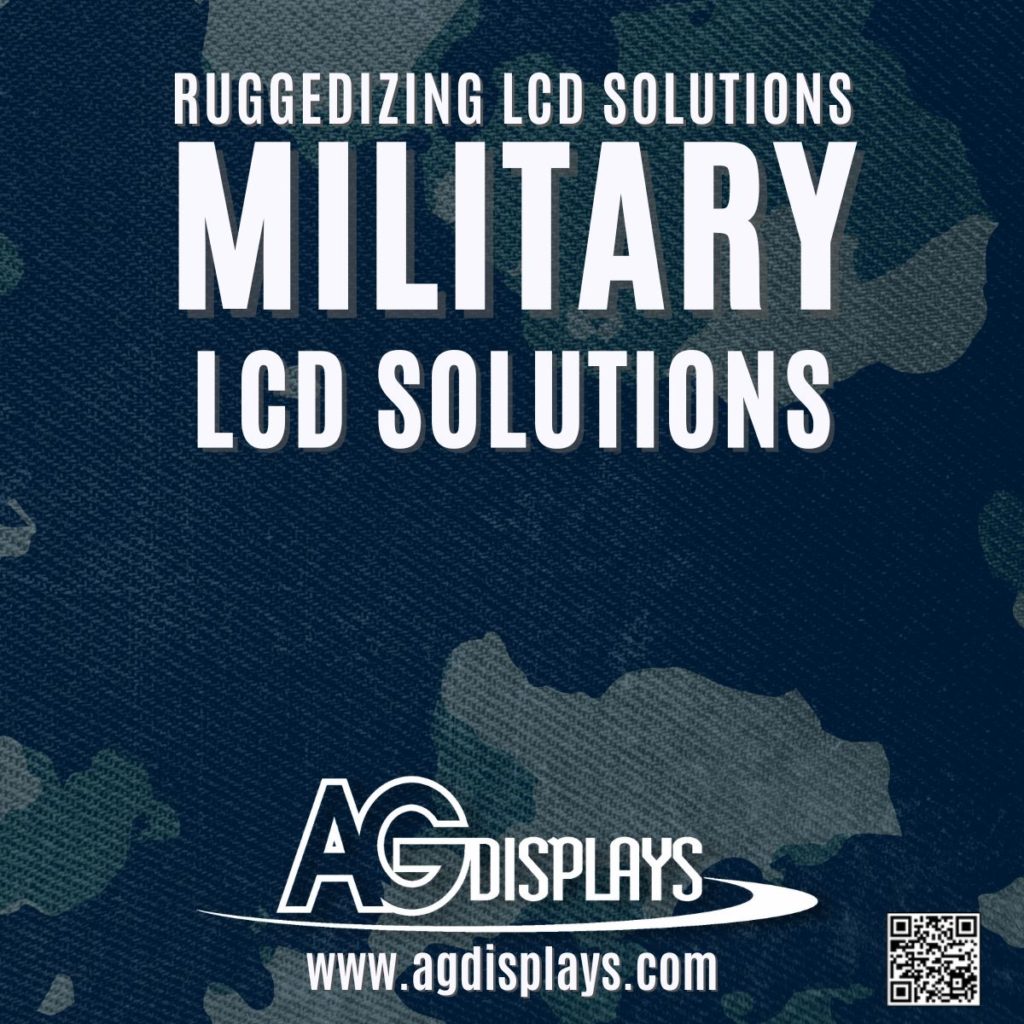
Cockpit Displays and Avionics
The integration of LCD technology into aviation, particularly in cockpit displays and avionics systems, has fundamentally transformed the way pilots interact with and gather critical information during flight. Here’s a deeper exploration of how LCD technology is revolutionizing aviation by providing pilots with sophisticated displays and multifunctional interfaces:
Heads-Up Displays (HUDs)
Heads-Up Displays represent a pinnacle of LCD technology in aviation. These transparent screens project critical flight data and situational information onto the pilot’s field of view, directly onto the cockpit windshield or a specialized screen. LCD-based HUDs offer essential flight parameters, such as airspeed, altitude, heading, navigation waypoints, and system status, allowing pilots to maintain focus outside the cockpit while receiving pertinent information in their line of sight.
Multifunctional Displays (MFDs)
LCD-based Multifunctional Displays are central components in modern cockpit configurations. These high-resolution screens consolidate an array of flight-related data and system controls into customizable layouts. MFDs offer pilots the flexibility to configure and display navigation maps, weather radar, engine performance indicators, fuel management, communication frequencies, and even surveillance feeds—all in a user-friendly interface. The adaptability of LCDs allows for the seamless integration of complex data sets, ensuring pilots have access to pertinent information at a glance.
Enhanced Situational Awareness
LCD screens in avionics systems are pivotal in providing pilots with enhanced situational awareness. With the integration of advanced graphics and real-time data, pilots can have a comprehensive view of the surrounding airspace, terrain, weather conditions, and nearby air traffic. These displays offer terrain awareness and warning systems (TAWS), traffic collision avoidance systems (TCAS), and weather radar overlays, aiding pilots in making informed decisions and avoiding potential hazards.
Night Vision and Variable Lighting Conditions
One of the remarkable features of LCD technology in aviation is its adaptability to varying lighting conditions. LCD displays are designed to maintain readability and visibility even under low-light or night-time operations. The screens incorporate adjustable backlighting and contrast controls, enabling pilots to maintain clarity and readability of information without compromising their vision or causing eye fatigue during extended flights.
Integration of Targeting Systems
In military aviation, LCD-based displays are integral components of targeting systems. These displays provide pilots with real-time targeting information, weapon status, and engagement parameters. LCD screens enable the integration of targeting pods, allowing pilots to track and engage targets with precision, enhancing combat effectiveness while minimizing collateral damage.
Extreme Environment Reliability
LCD technology in avionics is engineered to withstand extreme environmental conditions, including high altitudes, temperature variations, vibration, and electromagnetic interference. The robustness and durability of LCD displays ensure reliable performance throughout the flight envelope, contributing to the safety and operational efficiency of the aircraft.
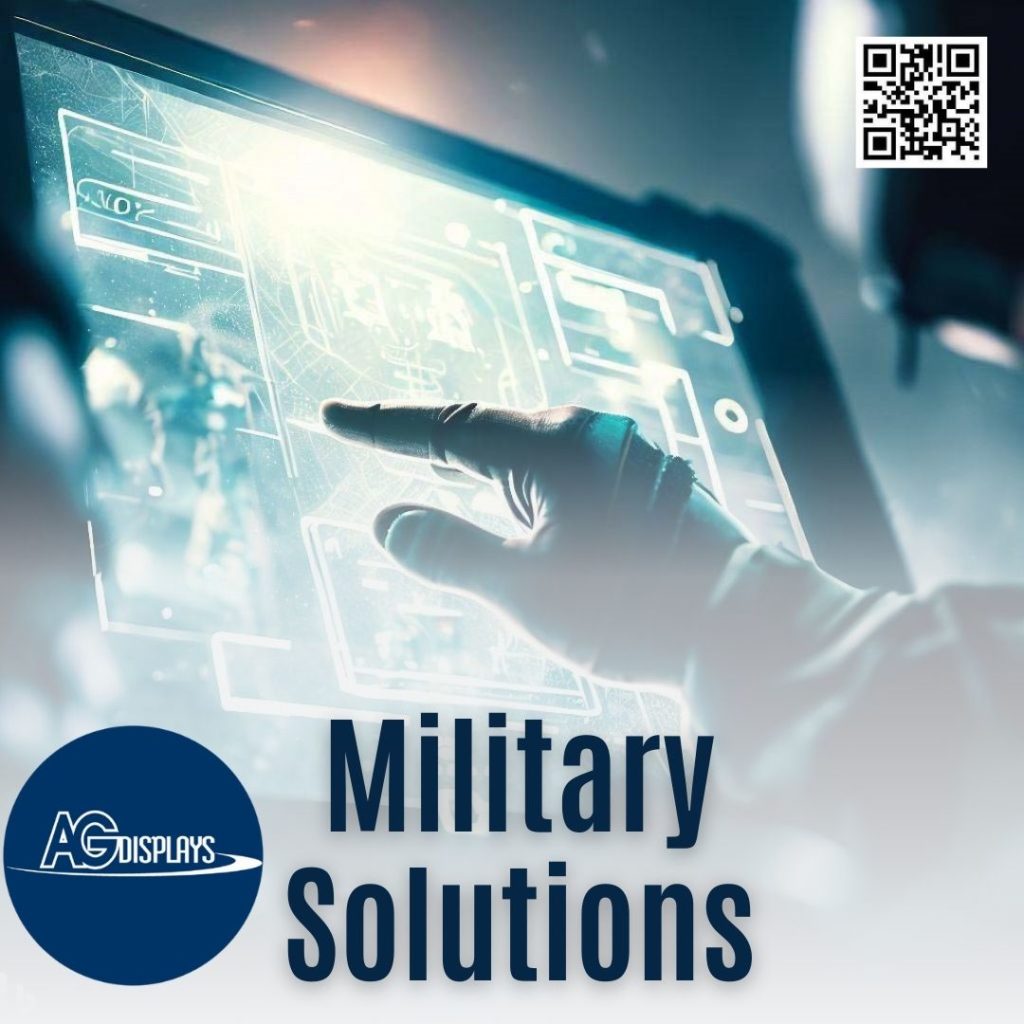
Battlefield Communication and Portable Devices
The integration of LCD technology into battlefield communication and portable devices has significantly transformed the way soldiers operate and communicate in modern warfare scenarios. Here’s an in-depth exploration of how ruggedized LCD screens are enhancing battlefield communication and providing soldiers with vital information:
Ruggedized Handheld Devices
Rugged tablets, laptops, and handheld communication devices equipped with LCD screens have become indispensable tools for soldiers on the battlefield. These devices are purpose-built to withstand extreme conditions, including harsh weather, dust, moisture, shock, and vibration. The ruggedized LCD screens used in these devices feature strengthened glass, anti-glare coatings, and reinforced frames to ensure durability and reliability in challenging environments.
Real-Time Information Access
The incorporation of LCD screens into these portable devices provides soldiers with immediate access to critical information, maps, and real-time mission updates. These displays offer high-resolution graphics, enabling troops to view tactical maps, operational plans, intelligence reports, and situational awareness data. Soldiers can swiftly retrieve and share vital information, enhancing decision-making and coordination among units in the field.
Communication Systems Integration
LCD technology is an integral part of advanced communication systems used by soldiers. Handheld radios, GPS devices, and communication terminals feature LCD screens that display encrypted messages, voice communications, mission briefings, and navigation data. These screens enable soldiers to maintain communication with command centers, fellow troops, and support units, ensuring seamless coordination and execution of missions.
Durability in Adverse Environments
The ruggedized LCD screens employed in battlefield devices are engineered to withstand extreme conditions encountered during combat operations. They are designed to operate reliably in extreme temperatures, high humidity, and varying altitudes. Additionally, these displays are resistant to scratches, impact, and exposure to harsh elements, ensuring uninterrupted performance even in the most demanding combat situations.
Night Vision Compatibility
Some LCD displays used in battlefield devices are designed to be compatible with night vision technology. These screens offer low-light and night-vision modes, ensuring readability without compromising soldiers’ ability to use night vision goggles or other low-light equipment. This feature enhances soldiers’ situational awareness during nighttime operations.
Mission Flexibility and Adaptability
Ruggedized handheld devices equipped with LCD screens provide soldiers with flexibility and adaptability in rapidly changing operational environments. These portable devices allow for quick adjustments, software updates, and information sharing, empowering soldiers to respond effectively to evolving mission requirements without being tethered to fixed communication centers.
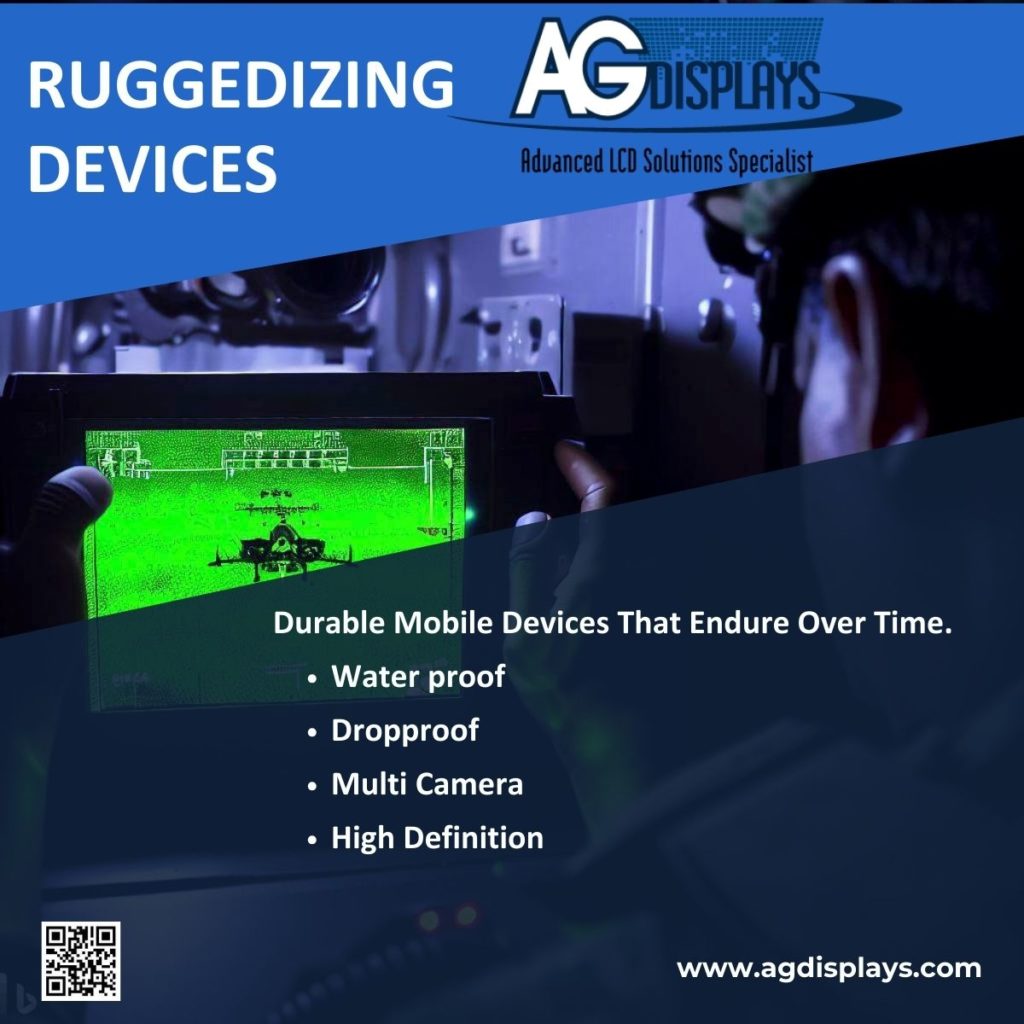
Surveillance and Reconnaissance
Surveillance and reconnaissance operations are integral components of modern military strategies, and the utilization of advanced LCD technology has significantly enhanced the capabilities and effectiveness of these missions. Here’s a comprehensive look at how advanced LCD displays are revolutionizing military surveillance and reconnaissance:
UAVs and Surveillance Drones
Unmanned Aerial Vehicles (UAVs) and surveillance drones serve as essential platforms for gathering intelligence and conducting reconnaissance in various operational theaters. These vehicles are equipped with high-resolution cameras, sensors, and sophisticated imaging systems that capture live video feeds and imagery. The integration of high-quality LCD screens within these unmanned platforms enables real-time transmission of visual data to ground control stations.
Real-Time Video Transmission
The high-resolution LCD screens employed in UAVs and surveillance drones facilitate the transmission of live video feeds and imagery in real-time. These displays provide ground control operators with a clear and detailed view of the operational area, allowing for immediate analysis and decision-making based on the gathered intelligence. The real-time transmission of visuals aids in monitoring activities, identifying targets, and assessing potential threats or hostile movements.
Intelligence Gathering and Target Identification
LCD screens play a pivotal role in intelligence gathering by providing high-fidelity visual data captured by UAVs and drones. The displays enable operators to observe landscapes, monitor key areas, and track moving targets with precision. The detailed imagery aids in target identification, pattern recognition, and the collection of actionable intelligence critical for mission planning, surveillance of high-value targets, and identifying potential threats.
Situational Awareness and Tactical Insights
The visual data transmitted through LCD screens contributes to enhancing situational awareness and providing ground commanders with tactical insights. Real-time surveillance feeds aid in monitoring changes in enemy positions, identifying hidden threats, and assessing battlefield dynamics. This comprehensive situational understanding enables commanders to make informed decisions, allocate resources effectively, and adapt strategies as needed in dynamic operational environments.
Support for Military Intelligence and Strategic Planning
The utilization of LCD displays in surveillance and reconnaissance operations significantly contributes to military intelligence and strategic planning. The detailed imagery and video feeds captured by UAVs and drones provide valuable insights into enemy movements, terrain analysis, infrastructure assessment, and potential threats. This information forms the basis for strategic decision-making, mission prioritization, and operational planning to achieve military objectives.
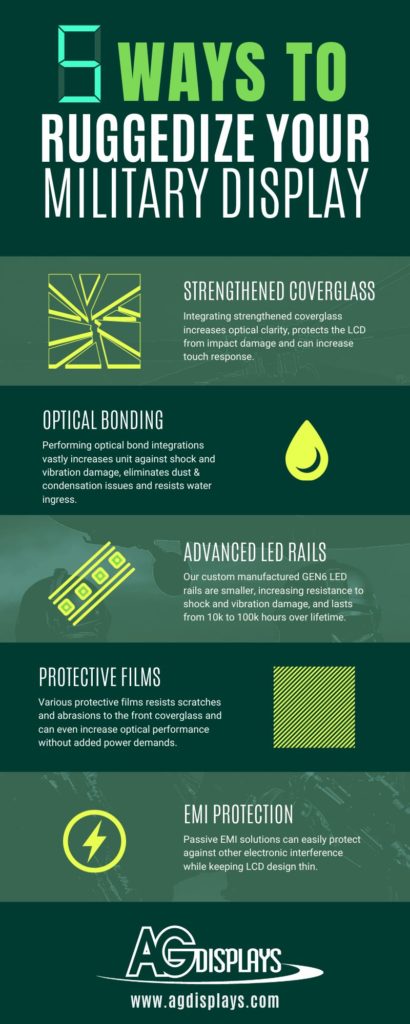
Training Simulators and Virtual Environments
The integration of LCD technology into military training simulators and virtual environments has transformed the landscape of training methodologies for military personnel. Here’s an in-depth look at how high-fidelity LCD displays are revolutionizing training simulations:
Realistic Simulation Environments
LCD displays serve as the visual interface for sophisticated training simulators, offering high-fidelity and immersive environments for military personnel. These displays are part of multi-screen setups or immersive visual systems that provide panoramic views, replicating realistic scenarios for various combat situations, vehicle operations, and mission rehearsals. The detailed visuals create an environment that closely resembles real-world situations.
Comprehensive Scenario Reproduction
LCD-based simulators accurately replicate diverse scenarios encountered in military operations. Whether it’s aircraft flight simulations, combat vehicle maneuvers, naval operations, or infantry tactics, the versatility of LCD displays allows for the creation of tailored training scenarios. These scenarios incorporate dynamic variables such as weather conditions, terrain features, enemy encounters, and mission-specific challenges, providing trainees with diverse and realistic experiences.
Enhanced Decision-Making and Skill Development
High-resolution LCD displays in training simulators facilitate decision-making exercises and skill development among military personnel. Trainees can practice responding to complex situations, making tactical decisions, and executing maneuvers in a risk-free environment. The interactive nature of simulations allows for immediate feedback, enabling trainees to analyze their actions, learn from mistakes, and refine their skills without actual battlefield exposure.
Mission Rehearsals and Procedural Training
LCD-equipped simulators play a crucial role in mission rehearsals and procedural training. Military units can rehearse missions, practice coordination among team members, and refine standard operating procedures (SOPs) in simulated environments. Trainees can run through mission sequences, conduct equipment checks, and practice communication protocols, ensuring readiness and cohesion before actual missions.
Safety and Risk Mitigation
One of the primary advantages of LCD-based training simulators is the mitigation of risks associated with live training exercises. By providing realistic yet controlled environments, these simulations allow trainees to familiarize themselves with complex equipment and procedures without endangering personnel or expensive assets. This approach minimizes the potential for accidents and equipment damage while maximizing training effectiveness.
Continual Training and Adaptability
LCD-based simulations offer the advantage of continual training and adaptability. These systems can be updated with evolving scenarios, new technologies, or changing tactics, ensuring that military personnel receive ongoing and relevant training. Simulators equipped with LCD displays remain adaptable to incorporate advancements in military strategies, equipment, and tactics.
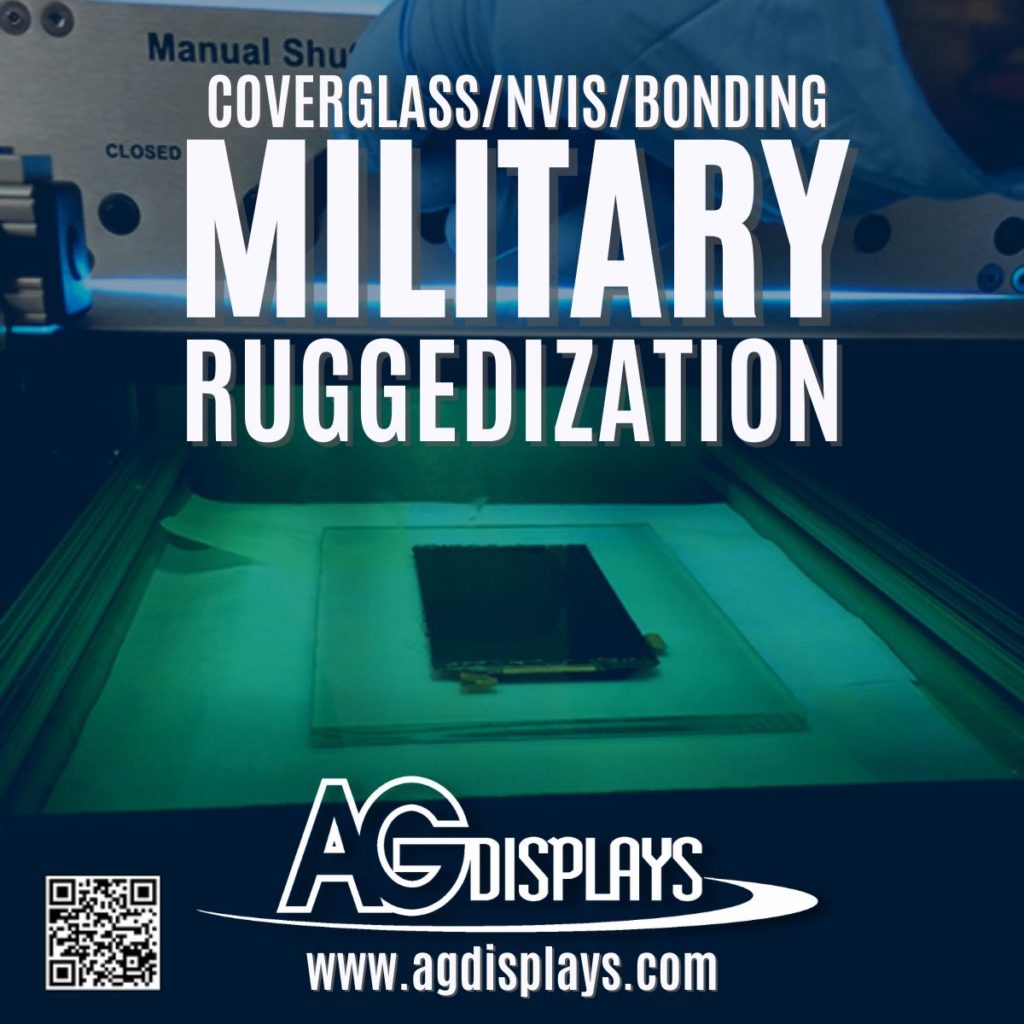
Vehicle and Equipment Interfaces
The integration of LCD technology into military vehicles and equipment has significantly enhanced their functionality, operational efficiency, and combat readiness. Here’s a detailed look at how LCD displays are transforming vehicle and equipment interfaces in military settings:
Instrumentation and Control Panels
LCD screens serve as central components in military vehicles and equipment, providing instrumentation and control panels for operators. These displays offer a user-friendly interface for monitoring critical systems, including engine performance, fuel levels, temperature, and hydraulic systems. They also provide access to vital controls for operating vehicle functions, such as lighting, communications, and auxiliary equipment.
Navigation and GPS Integration
Military vehicles and equipment are equipped with LCD-based navigation systems that display detailed maps, route information, and GPS data. These displays aid operators in navigation, route planning, and terrain assessment. The integration of GPS technology enables real-time positioning and accurate tracking, facilitating efficient movement and mission execution.
Weapon Systems Control
LCD technology plays a pivotal role in controlling and monitoring weapon systems mounted on military vehicles and naval vessels. These displays offer interfaces for targeting, firing controls, ammunition status, and surveillance feeds from onboard weaponry. Operators can efficiently manage and engage targets while maintaining situational awareness through visual data provided on the screens.
Surveillance and Sensor Integration
LCD screens in military vehicles integrate feeds from surveillance cameras, thermal imaging systems, and other sensors. These displays provide operators with real-time visual data, enhancing situational awareness by allowing them to monitor their surroundings, detect potential threats, and identify targets, even in challenging environments or adverse weather conditions.
Diagnostics and System Health Monitoring
LCD displays feature diagnostic capabilities that allow operators to monitor the health and status of vehicle systems. These displays provide alerts, warnings, and diagnostic reports for proactive maintenance, ensuring the operational readiness and reliability of the equipment. Operators can assess system health, identify issues, and take corrective actions promptly.
Integration of Communication Systems
Military vehicles and equipment incorporate LCD screens to facilitate communication systems. These displays provide interfaces for radio communication, message displays, encrypted communications, and inter-vehicle networks. Operators can manage communication channels, access mission updates, and coordinate with other units seamlessly through these interfaces.
Adaptability and User Interface Customization
LCD-based interfaces in military vehicles are designed to be adaptable and customizable to meet specific mission requirements. Operators can configure display layouts, prioritize information, and adjust settings based on operational needs. The flexibility of LCD screens allows for personalized and mission-specific user interfaces.
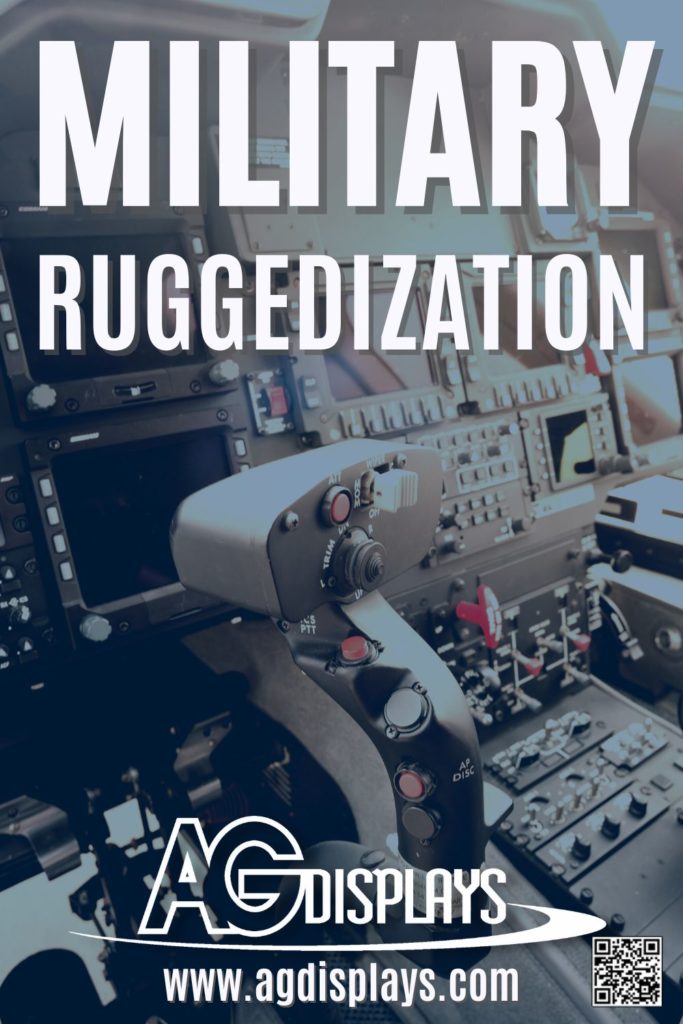
Future Developments and Advancements
The evolution of LCD technology in the military and defense sector continues to progress, driven by ongoing research, innovation, and a commitment to enhancing performance, reliability, and adaptability. Here’s an extensive exploration of the promising future developments and advancements in LCD technology within the military and defense industry:
Enhanced Display Resolutions
Future developments in LCD technology aim to push display resolutions to new heights, offering ultra-high-definition (UHD) and beyond. Advancements in pixel density and screen clarity will provide military personnel with even more detailed and crisp visual information. This enhancement in resolution will be particularly beneficial for applications requiring precise data visualization, such as surveillance, reconnaissance, and target identification.
Improved Durability and Robustness
Researchers are focused on further enhancing the durability and ruggedness of LCD displays to withstand extreme conditions encountered in military operations. The development of strengthened glass, impact-resistant materials, and improved protective coatings will ensure that LCD screens maintain functionality in harsh environments, including high temperatures, humidity, vibrations, and impacts, while retaining optimal performance.
Reduction in Power Consumption
Efforts are underway to optimize LCD technology for reduced power consumption without compromising performance. Advancements in energy-efficient backlighting, power management systems, and display components will extend the operational life of devices equipped with LCD screens. This reduction in power consumption is vital for extending mission durations and ensuring operational efficiency, especially in remote or prolonged deployments.
Integration with Augmented Reality (AR) and Artificial Intelligence (AI)
The integration of LCD displays with emerging technologies like augmented reality (AR) and artificial intelligence (AI) holds immense promise for military applications. LCD screens will serve as key components in AR-based headsets or visors, providing soldiers with augmented information overlays, real-time data visualization, and enhanced situational awareness. AI integration will enable LCD-equipped systems to process and analyze vast amounts of data, offering predictive analytics, decision support, and automated response capabilities.
Adaptability to Variable Environments
Future LCD displays will be designed to adapt seamlessly to variable environments, including varying lighting conditions, extreme temperatures, and challenging terrains. Adjustable brightness, improved contrast ratios, and anti-glare coatings will ensure optimal visibility and readability in diverse operational settings, enabling reliable performance regardless of environmental constraints.
Miniaturization and Flexible Form Factors
Advancements in LCD technology will lead to the development of smaller, thinner, and more flexible displays. This miniaturization will enable the integration of LCD screens into compact devices, wearable technologies, and flexible surfaces, offering soldiers versatile and adaptable tools for information access and communication in the field.
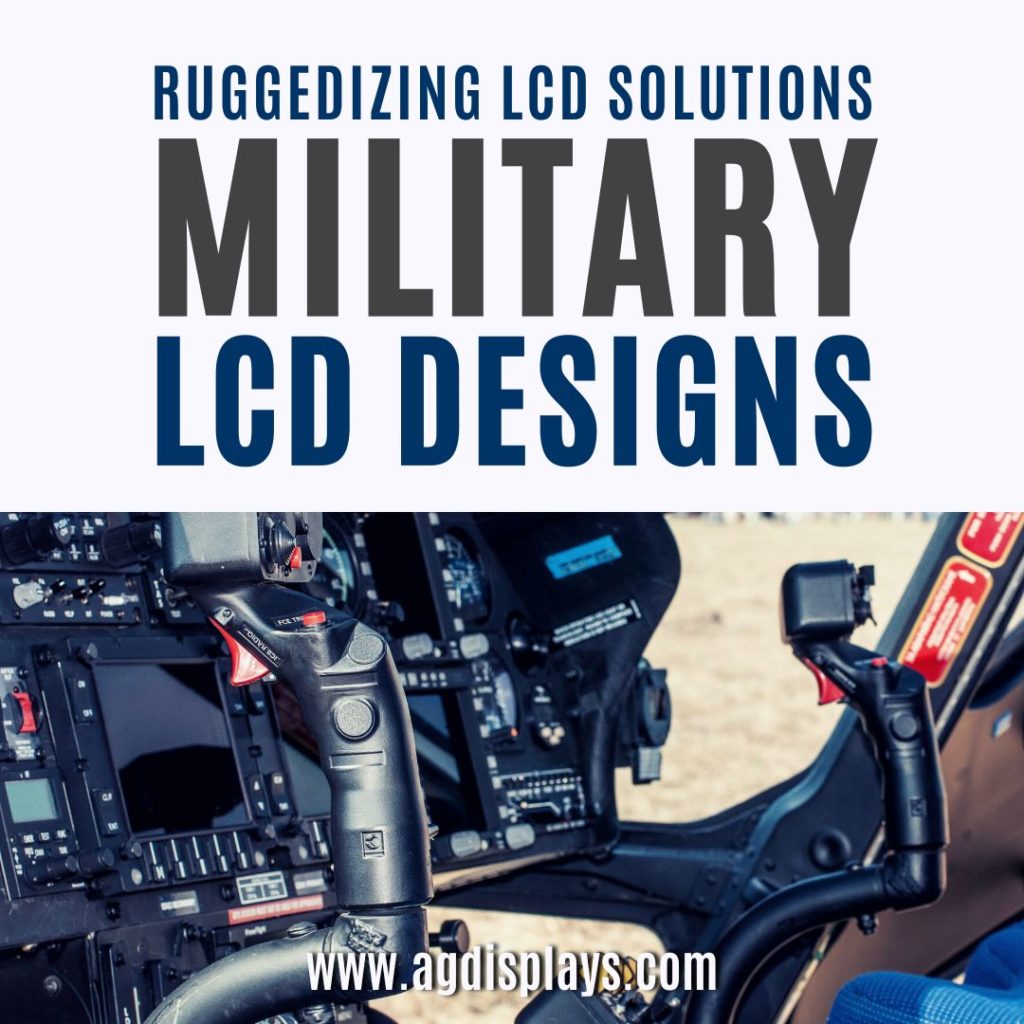
Conclusion
The pervasive integration of LCD technology across various facets of military and defense operations underscores its instrumental role in modern warfare. From enhancing situational awareness to empowering soldiers with critical information and facilitating sophisticated surveillance and reconnaissance, LCD displays have become indispensable assets in maintaining a technological edge on the battlefield.
To view our collection of off-the-shelf ready displays, please visit our Shopify channel: shop.agdisplays.com















